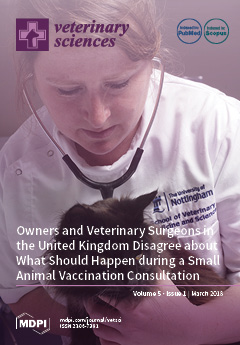Bovine anaplasmosis is endemic in South Africa and it has a negative economic impact on cattle farming. An improved understanding of
Anaplasma marginale and
Anaplasma marginale variety
centrale (A. centrale) transmission, together with improved tools for pathogen detection and characterisation, are required to
[...] Read more.
Bovine anaplasmosis is endemic in South Africa and it has a negative economic impact on cattle farming. An improved understanding of
Anaplasma marginale and
Anaplasma marginale variety
centrale (A. centrale) transmission, together with improved tools for pathogen detection and characterisation, are required to inform best management practices. Direct detection methods currently in use for
A. marginale and
A. centrale in South Africa are light microscopic examination of tissue and organ smears, conventional, nested, and quantitative real-time polymerase chain reaction (qPCR) assays, and a reverse line blot hybridisation assay. Of these, qPCR is the most sensitive for detection of
A. marginale and
A. centrale in South Africa. Serological assays also feature in routine diagnostics, but cross-reactions prevent accurate species identification. Recently, genetic characterisation has confirmed that
A. marginale and
A. centrale are separate species. Diversity studies targeting Msp1a repeats for
A. marginale and Msp1aS repeats for
A. centrale have revealed high genetic variation and point to correspondingly high levels of variation in
A. marginale outer membrane proteins (OMPs), which have been shown to be potential vaccine candidates in North American studies. Information on these OMPs is lacking for South African
A. marginale strains and should be considered in future recombinant vaccine development studies, ultimately informing the development of regional or global vaccines.
Full article






